Birdwatching is a captivating natural activity that not only allows individuals to connect with nature but also provides an opportunity to relax and enjoy the experience of observing and listening to the behavior of birds.
This activity's charm lies in its endless challenges and enjoyment, making it accessible and enjoyable for both beginners and seasoned enthusiasts alike.
The appeal of birdwatching is that it has a very low entry threshold. All one needs is a pair of binoculars and a bird identification manual to embark on this journey of intimate contact with nature. This simplicity makes it easy for anyone to start exploring the fascinating world of birds.
The world is home to an incredible variety of bird species. As of 2014, over 10,000 bird species had been identified globally. Each region has its unique bird population, adding to the richness of the birdwatching experience.
For instance, in Finland, 478 bird species had been observed and recorded as of 2018. The colors and shapes of birds' feathers change with age and season, making the activity even more challenging and intriguing.
Birdwatching is not just a visual experience; different species can also be identified by their distinct calls and songs, adding an auditory dimension to the activity.
There are various methods to enjoy birdwatching. In addition to regular visual observation, photography offers another way to capture and record the stunning moments of birds.
Winter feeding is a practice that provides birds with additional food resources during the cold months, creating more observation opportunities for birdwatchers. By listening to birdsong, especially during the spring and autumn migration seasons, enthusiasts have the chance to discover rare species.
Bird banding, a highly specialized activity, involves placing identification rings on birds. This practice helps researchers better understand migration routes and behavioral patterns. These diverse birdwatching methods not only enrich the experience but also contribute valuable data to scientific research.
Birds have adapted to a wide range of habitats, from forests to wetlands, from mountains to deserts. Their presence is nearly ubiquitous on Earth. Migratory birds, in particular, showcase remarkable survival abilities.
They undertake long-distance migrations between breeding and wintering grounds every year, with some species traveling thousands of kilometers.
This awe-inspiring migration draws countless birdwatching enthusiasts who follow these birds along popular migration routes. For many, this is not only an expression of admiration for nature but also a celebration of the vitality and resilience of these creatures.
Birdwatching goes beyond being a mere personal hobby; it holds significant social value as well. Many birdwatchers join local birding societies where they can share experiences and insights with like-minded individuals and participate in group activities.
These gatherings not only foster a sense of community but also promote environmental education and nature conservation. Additionally, for those who prefer solitude, birdwatching alone in the serene outdoors is an ideal way to escape the hustle and bustle of city life and alleviate stress.
Whether sharing the joy of birdwatching with friends or enjoying the tranquility of nature in solitude, this activity is both enriching and meaningful.
As an endeavor that combines scientific exploration with the enjoyment of nature, birdwatching deepens people's awareness of bird diversity and the significance of ecosystems. It also nurtures a love for nature and a consciousness of environmental protection.
With growing environmental awareness, birdwatching is likely to attract even more participants. Whether you are a beginner just starting or a seasoned veteran, the world of birdwatching offers endless opportunities for exploration and discovery.


